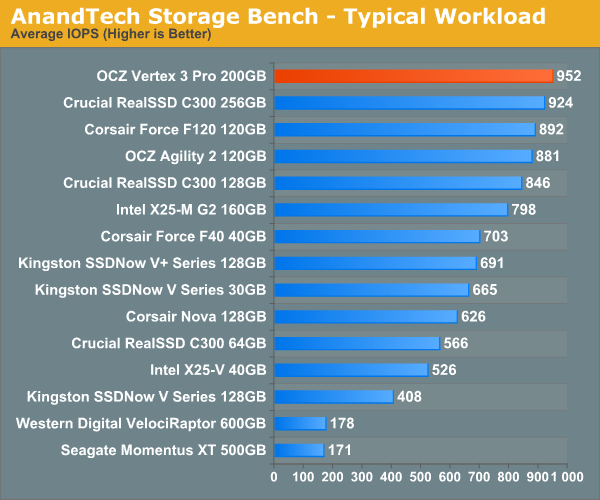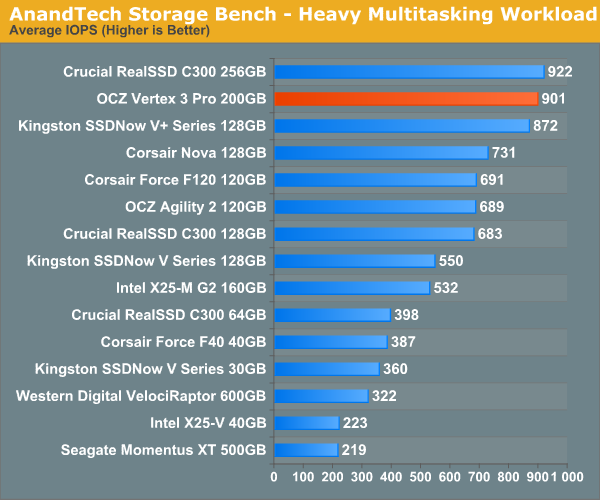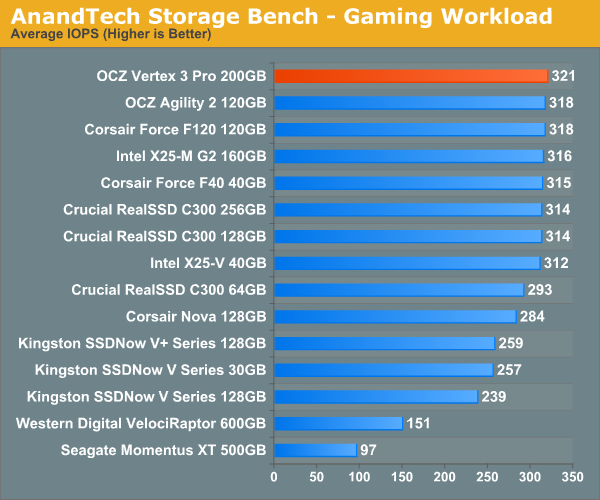OCZ Vertex 3 Pro Preview: The First SF-2500 SSD
by Anand Lal Shimpi on February 17, 2011 3:01 AM ESTAnandTech Storage Bench 2010
To keep things consistent we've also included our older Storage Bench. Note that the old storage test system doesn't have a SATA 6Gbps controller, so we only have one result for the Vertex 3 Pro (and the C300). The SF-2500 controller does respectably here, but with a 3Gbps controller we're only marginally faster than other SSDs (which is why we've moved to a new storage platform for 2011).
The first in our benchmark suite is a light/typical usage case. The Windows 7 system is loaded with Firefox, Office 2007 and Adobe Reader among other applications. With Firefox we browse web pages like Facebook, AnandTech, Digg and other sites. Outlook is also running and we use it to check emails, create and send a message with a PDF attachment. Adobe Reader is used to view some PDFs. Excel 2007 is used to create a spreadsheet, graphs and save the document. The same goes for Word 2007. We open and step through a presentation in PowerPoint 2007 received as an email attachment before saving it to the desktop. Finally we watch a bit of a Firefly episode in Windows Media Player 11.
There’s some level of multitasking going on here but it’s not unreasonable by any means. Generally the application tasks proceed linearly, with the exception of things like web browsing which may happen in between one of the other tasks.
The recording is played back on all of our drives here today. Remember that we’re isolating disk performance, all we’re doing is playing back every single disk access that happened in that ~5 minute period of usage. The light workload is composed of 37,501 reads and 20,268 writes. Over 30% of the IOs are 4KB, 11% are 16KB, 22% are 32KB and approximately 13% are 64KB in size. Less than 30% of the operations are absolutely sequential in nature. Average queue depth is 6.09 IOs.
The performance results are reported in average I/O Operations per Second (IOPS):

If there’s a light usage case there’s bound to be a heavy one. In this test we have Microsoft Security Essentials running in the background with real time virus scanning enabled. We also perform a quick scan in the middle of the test. Firefox, Outlook, Excel, Word and Powerpoint are all used the same as they were in the light test. We add Photoshop CS4 to the mix, opening a bunch of 12MP images, editing them, then saving them as highly compressed JPGs for web publishing. Windows 7’s picture viewer is used to view a bunch of pictures on the hard drive. We use 7-zip to create and extract .7z archives. Downloading is also prominently featured in our heavy test; we download large files from the Internet during portions of the benchmark, as well as use uTorrent to grab a couple of torrents. Some of the applications in use are installed during the benchmark, Windows updates are also installed. Towards the end of the test we launch World of Warcraft, play for a few minutes, then delete the folder. This test also takes into account all of the disk accesses that happen while the OS is booting.
The benchmark is 22 minutes long and it consists of 128,895 read operations and 72,411 write operations. Roughly 44% of all IOs were sequential. Approximately 30% of all accesses were 4KB in size, 12% were 16KB in size, 14% were 32KB and 20% were 64KB. Average queue depth was 3.59.

The gaming workload is made up of 75,206 read operations and only 4,592 write operations. Only 20% of the accesses are 4KB in size, nearly 40% are 64KB and 20% are 32KB. A whopping 69% of the IOs are sequential, meaning this is predominantly a sequential read benchmark. The average queue depth is 7.76 IOs.











144 Comments
View All Comments
HangFire - Friday, February 18, 2011 - link
As a software engineer, I can tell you that temp files are used over in-memory storage because the s/w was originally written that way, and no bug report concerning them will ever reach high priority status because it is ranked as a system configuration issue that can be fixed by the user.In other words, inertia of the "good enough" file writing code (written when RAM was sparse) will prevent software from being re-written to more optimal in-memory usage. The long backlog of truly important bugs taking precedence insures that.
You have a good point about ramdisks competing with disk caching. What is optimal depends on your application load, and to some extent your storage subsystem.
cdillon - Thursday, February 17, 2011 - link
The idea of moving the page-file to a RAM disk makes my head hurt. That's just retarded. You'd do better to turn off paging entirely, but that's also of questionable benefit because paging isn't really that hard on your SSD.Putting the temp directory along with browser caches and other non-critical frequently-written data is not a bad idea as long as you don't over-do it. The only problem with putting the temp drive on a volatile software-based RAM drive is that any software installation you do that requires a reboot with intermediate installer files kept in the temp directory which are expected to be there on the next reboot is going to fail.
Qapa - Saturday, February 19, 2011 - link
Hi Anand,I second this request :)
A few changes though:
- DISABLE page file
--- no matter if you have SSD or HDD, windows writes to the page file even if only using 10% of RAM), so you decrease writes to disk which does 2 thing: increase life of disk and increase speed of system. possibly both only marginally, but that's what benchs would show;
- browser caches
--- for sure this is one of the most wasteful disk writing and it should be more and more a great amount of writes since we are ever more on the web
- temporary folders
--- as someone else mentions you could come into problems if you need a install-reboot-finish_install kind of instalation
--- and I agree, with the sw engineer - if it works it won't get changed, so programs will put stupid stuff to files just because that was the way they did it at some point in time
I think a 1-2Gb RAM Disk is more than enough for browser and temp files, considering an initial starting RAM size of 4-8Gb of RAM. And yes, I do believe this improves system performance.
Can you do the benchs?
Thanks for the site - all reviews - and hope you can add this request as another review.
shawkie - Thursday, February 17, 2011 - link
I notice that the Intel SSD 510 has just started to appear on some retailer websites. It looks like it is SATA 6Gbs and comes in 120GB and 250GB versions. Pricing looks pretty high at this point.BansheeX - Thursday, February 17, 2011 - link
Color me unexcited. SSD is fast and reliable enough for people to want it. The price per GB isn't coming down anywhere near as fast as other technologies. I paid $200 1.5 years ago for an 80GB SSD drive that goes for $180 today.chrysrobyn - Friday, February 18, 2011 - link
Maybe 80GB for $200 is good enough for you, but I need twice that capacity, and I'm unwilling to pay more than $200. The next generation of SSDs that are coming out between now and May are going to come far closer to that price point for me.seapeople - Friday, February 18, 2011 - link
The point is that 1.5 years ago the OP purchased a SSD for $2.5/GB which had anywhere from a 2x-30x performance improvement over its predecessor (HD's), and here we are in 2011 reading a review about the next generation SSD which uses smaller, cheaper flash with half the available write-cycle life which is going to sell for... $5/GB and get a 1.2x-3x performance improvement over its predecessor (initial SSD's).What's next? A solid state drive that reads and writes at 2,000 GB/s and sells for $10,000 for the 1 TB model? Oh I can't wait for that.
ABR - Saturday, February 19, 2011 - link
I have to agree. Year after year we see more and more mind-boggling performance improvements over regular HDDs, but little or no price drop. Perhaps the materials costs are just insurmountable and the replacement of HDDs won't be happening after all. SSDs will be like SLR digital cameras -- premium and professional use only, and pricing a previous generation of amateur users out of a market they used to be in.FunBunny2 - Saturday, February 19, 2011 - link
From what I see: as each feature size drop in the NAND, the controller has to get increasingly more byzantine, needs more cache, and so on just to maintain performance. Word is that IMFT 25nm includes an ECC engine on die!!!Aernout - Saturday, February 19, 2011 - link
Maybe we wil hear more of the hybride disks like the momentus XT from seagate in the future, for 'standard' users they can offer a lot.now they have a 4 gb flash with 500 gb but its 10 months old.
I think lots of people are hoping they will multiply those specs.
I'm thinking of getting one for my laptop, but then on the otherside i am not sure if i will use 500 gig on my laptop, maybe i should buy a 64 ssd in stead.